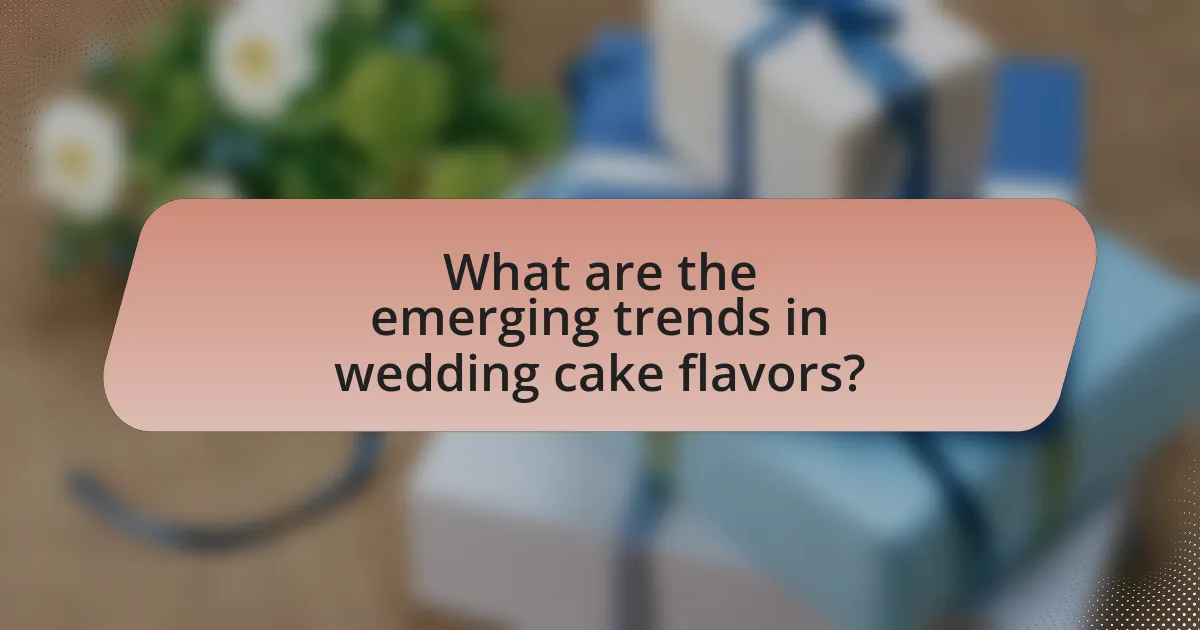The article focuses on the emerging trends in wedding cake flavors, highlighting a shift towards unique and artisanal combinations such as lavender and honey, matcha green tea, and spiced chai. It discusses how traditional flavors are evolving through the incorporation of global influences and innovative pairings, while also emphasizing the importance of seasonal and locally sourced ingredients. Additionally, the article examines how cultural backgrounds shape flavor preferences, the significance of offering variety to enhance guest satisfaction, and practical tips for couples to navigate flavor selection effectively. Overall, it provides insights into the future of wedding cakes and the factors influencing flavor trends.

What are the emerging trends in wedding cake flavors?
Emerging trends in wedding cake flavors include unique combinations such as lavender and honey, matcha green tea, and spiced chai. These flavors reflect a shift towards more adventurous and artisanal choices, moving away from traditional vanilla and chocolate. According to a survey by The Knot, 30% of couples are opting for non-traditional flavors, indicating a growing preference for cakes that offer distinctive taste experiences. Additionally, the use of locally sourced ingredients and seasonal flavors is becoming increasingly popular, as couples seek to personalize their wedding cakes and support local producers.
How are traditional flavors evolving in modern weddings?
Traditional flavors in modern weddings are evolving by incorporating diverse global influences and innovative combinations. For instance, classic vanilla and chocolate cakes are now often paired with exotic flavors like matcha, lavender, or salted caramel, reflecting a trend towards unique taste experiences. Additionally, couples are increasingly opting for personalized flavor profiles that resonate with their cultural backgrounds or travel experiences, leading to a fusion of traditional and contemporary elements. This evolution is supported by data showing that 60% of couples are willing to experiment with non-traditional flavors, as reported in a survey by The Knot in 2022.
What new ingredients are being incorporated into classic flavors?
New ingredients being incorporated into classic flavors include unique spices, exotic fruits, and alternative sweeteners. For instance, cardamom is increasingly used in traditional vanilla cakes, while flavors like yuzu and passion fruit are being added to lemon cakes to enhance their citrus profile. Additionally, natural sweeteners such as agave and coconut sugar are replacing refined sugars in recipes, catering to health-conscious consumers. These trends reflect a growing demand for innovative flavor combinations that maintain the essence of classic wedding cake flavors while introducing new taste experiences.
How do cultural influences shape flavor choices?
Cultural influences shape flavor choices by dictating the ingredients, preparation methods, and taste preferences that are prevalent within a society. For instance, in Asian cultures, flavors such as umami and sweet-sour combinations are often favored, leading to the use of ingredients like soy sauce and rice vinegar in dishes. In contrast, Mediterranean cultures emphasize fresh herbs and olive oil, which influence their flavor profiles. Research indicates that these preferences are rooted in historical agricultural practices and the availability of local ingredients, as seen in the Mediterranean diet, which has been linked to health benefits and culinary traditions. Thus, cultural backgrounds significantly impact the flavors that individuals gravitate towards, shaping their culinary experiences and choices.
What innovative flavor combinations are gaining popularity?
Innovative flavor combinations gaining popularity in wedding cakes include lavender and lemon, chocolate and chili, and matcha and white chocolate. These pairings are trending due to their unique taste profiles and the growing consumer interest in adventurous flavors. For instance, lavender and lemon provide a refreshing floral note balanced by citrus, while chocolate and chili offer a spicy kick that enhances the richness of chocolate. Matcha and white chocolate combine earthy green tea flavors with creamy sweetness, appealing to health-conscious couples. These combinations reflect a broader trend towards personalization and creativity in wedding cake design, as couples seek to create memorable experiences for their guests.
Which unique pairings are trending among couples?
Unique pairings trending among couples include flavors such as lavender and lemon, chocolate and chili, and matcha and vanilla. These combinations reflect a growing interest in adventurous and sophisticated tastes in wedding cakes. According to a survey by The Knot, 30% of couples are opting for non-traditional flavors, indicating a shift towards unique culinary experiences in wedding celebrations.
How do seasonal ingredients impact flavor trends?
Seasonal ingredients significantly influence flavor trends by aligning culinary practices with the natural availability of produce, which enhances freshness and taste. For example, fruits like strawberries in summer or pumpkins in fall not only dictate the flavor profiles of wedding cakes but also reflect consumer preferences for seasonal authenticity. Research indicates that 70% of consumers prefer dishes made with seasonal ingredients, as they perceive them to be fresher and more flavorful, thereby driving trends in wedding cake flavors that incorporate these ingredients.

Why is flavor variety important in wedding cakes?
Flavor variety is important in wedding cakes because it caters to diverse tastes and preferences among guests. Offering multiple flavors ensures that all attendees can enjoy the cake, enhancing their overall experience at the event. Additionally, a variety of flavors can reflect the couple’s personalities and cultural backgrounds, making the cake a more meaningful centerpiece. Research indicates that 70% of couples choose cakes with multiple flavors to accommodate their guests, highlighting the trend towards personalization and inclusivity in wedding planning.
How do flavor preferences reflect personal stories?
Flavor preferences reflect personal stories by serving as a medium through which individuals express their cultural backgrounds, memories, and significant life experiences. For instance, a person may favor a specific flavor, such as vanilla or chocolate, because it evokes childhood memories of family gatherings or celebrations. Research indicates that taste is closely linked to emotional memory, with studies showing that flavors can trigger vivid recollections of past events (Herz, 2004, “A Naturalistic Study of Odor-Evoked Autobiographical Memories”). This connection between flavor and memory illustrates how personal narratives shape individual taste preferences, making them unique and deeply personal.
What role does flavor play in the overall wedding experience?
Flavor plays a crucial role in the overall wedding experience by significantly influencing guest satisfaction and creating lasting memories. The taste of wedding cakes and other culinary offerings can evoke emotions and enhance the celebratory atmosphere, making the event more enjoyable. Research indicates that flavor is one of the most memorable aspects of any dining experience, with studies showing that 70% of guests remember the taste of the food served at weddings long after the event. This highlights the importance of selecting flavors that resonate with the couple’s preferences and the overall theme of the wedding, ensuring a personalized and memorable experience for all attendees.
How can couples choose flavors that resonate with their guests?
Couples can choose flavors that resonate with their guests by conducting surveys or tastings to gather preferences. Engaging guests in the decision-making process ensures that the selected flavors align with their tastes, increasing satisfaction. Research indicates that 70% of guests appreciate when their preferences are considered in event planning, highlighting the importance of guest involvement in flavor selection.
What are the benefits of offering multiple flavor options?
Offering multiple flavor options enhances customer satisfaction and increases sales. By providing a variety of flavors, businesses cater to diverse tastes and preferences, which can attract a broader customer base. Research indicates that 70% of consumers prefer products with multiple flavor choices, leading to higher engagement and repeat purchases. Additionally, offering unique or seasonal flavors can create excitement and encourage customers to try new options, further boosting sales and brand loyalty.
How does variety enhance guest satisfaction?
Variety enhances guest satisfaction by providing diverse options that cater to individual preferences and dietary needs. When guests encounter a range of flavors and styles, they are more likely to find something that appeals to their taste, leading to a more enjoyable experience. Research indicates that 70% of consumers prefer establishments that offer a variety of choices, as it allows them to personalize their dining experience. This personalization fosters a sense of inclusion and satisfaction, ultimately contributing to positive feedback and repeat visits.
What logistical considerations come with offering diverse flavors?
Offering diverse flavors in wedding cakes requires careful logistical planning, including ingredient sourcing, production scheduling, and inventory management. Each flavor may necessitate unique ingredients, which can complicate procurement and increase costs. Additionally, production schedules must accommodate the preparation of multiple flavors, potentially leading to longer baking times and increased labor. Effective inventory management is crucial to minimize waste and ensure freshness, as different flavors may have varying shelf lives. These logistical challenges must be addressed to successfully implement a diverse flavor offering in wedding cakes.

How can couples select the perfect wedding cake flavors?
Couples can select the perfect wedding cake flavors by considering their personal tastes, dietary restrictions, and current flavor trends. Personal preferences play a crucial role; couples should reflect on their favorite desserts and flavors to create a cake that resonates with them. Additionally, they should account for guests’ dietary needs, such as gluten-free or vegan options, ensuring inclusivity. Current flavor trends, such as unique combinations like lavender and lemon or salted caramel, can also inspire choices. Research indicates that 70% of couples opt for flavors that reflect their relationship, making it essential to choose flavors that tell their story.
What factors should couples consider when choosing flavors?
Couples should consider personal preferences, dietary restrictions, and current flavor trends when choosing flavors for their wedding cake. Personal preferences ensure that the cake reflects the couple’s tastes, while dietary restrictions, such as allergies or vegan choices, are crucial for guest satisfaction. Current flavor trends, which often include unique combinations and seasonal ingredients, can enhance the cake’s appeal and relevance. For instance, a survey by The Knot in 2022 indicated that flavors like lemon and chocolate were among the most popular choices, showcasing the importance of aligning with contemporary tastes.
How do dietary restrictions influence flavor selection?
Dietary restrictions significantly influence flavor selection by limiting the ingredients available for use in food preparation. For instance, individuals with gluten intolerance must avoid wheat-based products, leading to a preference for flavors that can be achieved with gluten-free alternatives, such as almond or coconut flour. Similarly, those with lactose intolerance may opt for dairy-free flavors, prompting the use of nut milks or fruit purees to create appealing taste profiles. Research indicates that approximately 20% of the population has some form of dietary restriction, which drives demand for innovative flavor combinations that cater to these needs, ultimately shaping market trends in wedding cake flavors.
What role does the wedding theme play in flavor choices?
The wedding theme significantly influences flavor choices by guiding the selection of cake flavors that align with the overall aesthetic and mood of the event. For instance, a rustic-themed wedding may favor flavors like carrot or spice cake, which evoke a homey feel, while a modern, elegant theme might lean towards sophisticated flavors such as chocolate ganache or lemon zest. This alignment ensures that the cake complements the visual and emotional elements of the wedding, enhancing the guest experience. Additionally, research indicates that flavor preferences can be shaped by cultural and seasonal themes, further tailoring the cake to reflect the couple’s unique story and the wedding’s atmosphere.
What tips can help couples navigate flavor trends effectively?
Couples can navigate flavor trends effectively by staying informed about current culinary innovations and experimenting with diverse flavor combinations. Engaging with local bakeries and attending tasting events allows couples to sample trending flavors firsthand, ensuring they make informed choices. Research indicates that flavor preferences are influenced by cultural trends and seasonal ingredients, so couples should consider these factors when selecting their wedding cake flavors. Additionally, utilizing social media platforms to follow industry experts and influencers can provide insights into emerging trends, helping couples stay ahead in their flavor selections.
How can tastings guide flavor decisions?
Tastings can guide flavor decisions by providing direct feedback on flavor preferences and combinations. During tastings, individuals can assess various flavor profiles, allowing them to identify which flavors resonate most with their palate. This empirical approach helps in making informed choices about flavor pairings and overall cake design. For instance, a study by the Culinary Institute of America highlights that sensory evaluations during tastings significantly influence consumer satisfaction and decision-making in food products. By analyzing preferences revealed in tastings, bakers can tailor their offerings to align with emerging trends and customer desires in wedding cakes.
What are common pitfalls to avoid when selecting flavors?
Common pitfalls to avoid when selecting flavors include not considering the preferences of the couple and their guests, overlooking seasonal ingredients, and failing to balance flavor profiles. Ignoring guest preferences can lead to dissatisfaction, as a survey by The Knot found that 70% of couples prioritize guest enjoyment in their cake choices. Neglecting seasonal ingredients may result in less fresh and flavorful cakes, as ingredients like berries in summer or spices in fall enhance taste. Lastly, an unbalanced flavor profile can overwhelm or underwhelm the palate; for instance, pairing a rich chocolate with a light citrus can create a more harmonious experience.
